When you crave ice cream, it’s not just about the taste. The brain’s reward system releases dopamine, making you feel pleasure and satisfaction. Plus, nostalgia plays a huge role—thoughts of childhood memories often surface when indulging. Ice cream’s high sugar and fat content can also lead to addictive cravings, making you want more over time. If you’re curious about the factors influencing these cravings, there’s even more to discover.
Key Takeaways
- Ice cream triggers dopamine release, activating the brain’s reward system and creating feelings of pleasure and satisfaction.
- The high sugar and fat content leads to cravings, making it hard to resist and often requiring larger portions for the same satisfaction.
- Emotional connections and nostalgic memories associated with ice cream enhance its desirability, often linked to childhood and celebrations.
- Environmental cues, like sunny weather or social gatherings, increase the urge to indulge in ice cream as a comfort food.
- The creamy texture and sweet flavors appeal to genetic preferences, further driving cravings for this indulgent treat.
The Brain’s Reward System and Ice Cream
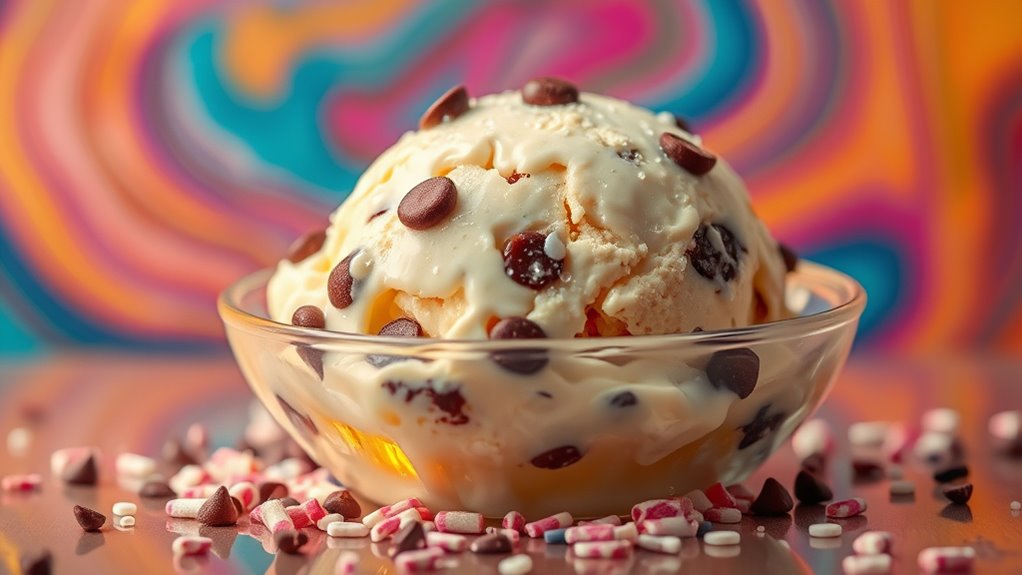
When you indulge in a scoop of ice cream, your brain responds with a rush of pleasure by releasing dopamine, a neurotransmitter that signals reward and satisfaction. This delightful treat activates key brain regions like the striatum and nucleus accumbens, enhancing your experience through its creamy texture and rich flavors. The high sugar and fat content in ice cream triggers powerful ‘wanting’ responses, making you crave more. Each bite sends a dopamine surge, solidifying your desire for this tasty reward. However, frequent indulgence can lead to tolerance, meaning you may need larger portions to achieve the same pleasure. Your brain’s reward system adapts over time, influencing how you experience cravings for ice cream and other high-calorie foods. Interestingly, the multi-sensory experience of ice cream enhances overall pleasure, making each scoop even more irresistible. Additionally, consuming foods high in sugar can lead to increased depression rates, showcasing the complex relationship between our dietary choices and mental health. Interestingly, the average ice cream consumption per person in the U.S. is about 23 pounds annually, showcasing the widespread popularity of this treat. Many people also enjoy alternatives like frozen yogurt pops, which offer a refreshing and lower-calorie option. Furthermore, high-fat and high-sugar foods like ice cream can lead to increased juice cravings due to similar activating effects on the brain’s reward system.
Nostalgia and Emotional Connections
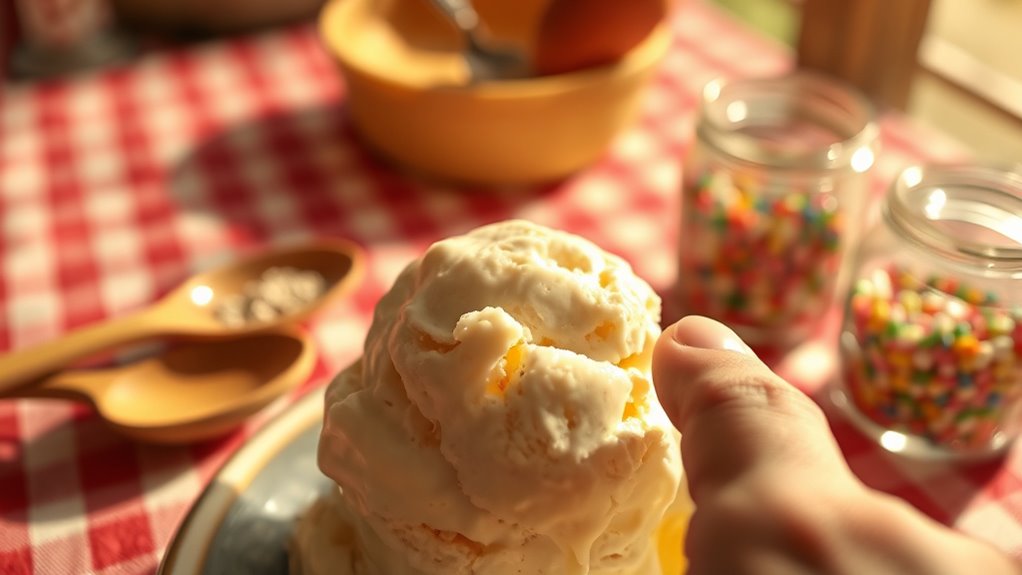
Indulging in ice cream doesn’t just activate your brain’s reward system; it also stirs up fond memories and emotional connections. You might find that the taste and smell of ice cream transport you back to childhood summers, birthday parties, or family celebrations. These sensory experiences evoke feelings of comfort and security, providing a welcome escape from daily stress. Ice cream is more than a treat; it’s intertwined with cultural traditions and social interactions that strengthen bonds with friends and family. For many, familiar flavors evoke a sense of belonging, while innovative nostalgic flavors tap into cherished past experiences. Furthermore, enjoying ice cream can be a protein-rich start to your day, similar to how breakfast items can provide comfort and energy. Additionally, regular consumption of ice cream, especially those high in sugar, may contribute to overall calorie intake, making moderation essential for maintaining health. The fermentation process of certain desserts can enhance their flavor profiles, making them even more enjoyable. Desserts like Dirt Cups can also evoke similar nostalgic feelings, making them a beloved choice for gatherings. Ultimately, ice cream serves as both a delightful indulgence and a comforting reminder of joyful moments in your life, reinforcing the idea that comfort food serves as a mechanism for coping with feelings of isolation.
The Role of Thermoregulation
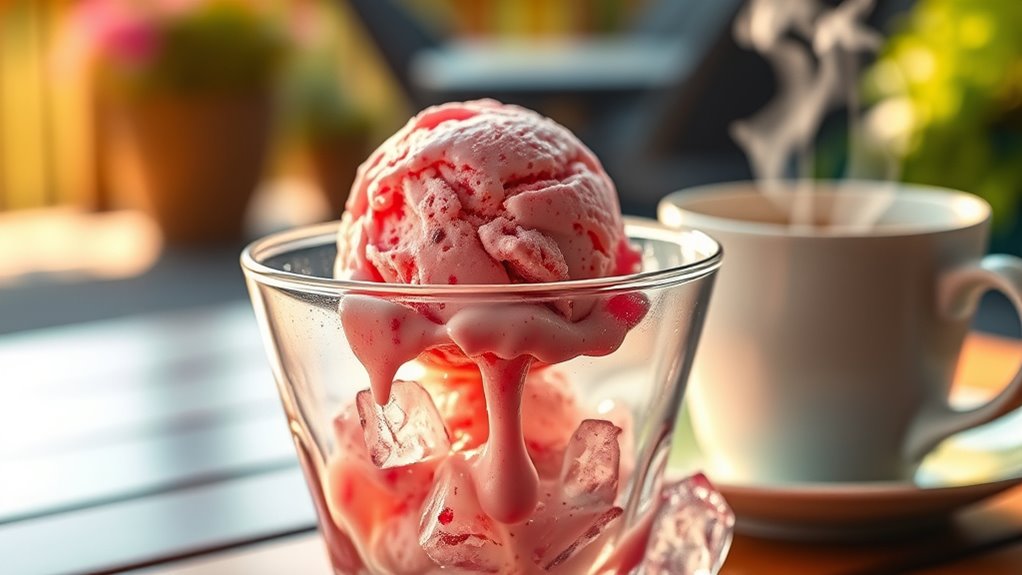
Though ice cream offers a delightful sensory experience, it doesn’t greatly impact your core body temperature due to the body’s intricate thermoregulation processes.
Ice cream may be refreshing, but it has little effect on core body temperature due to our body’s thermoregulation.
When you enjoy ice cream, the cooling sensation primarily affects your mouth and throat, thanks to cold receptors. This brief relief is merely psychological; your core temperature remains stable. In fact, digesting ice cream’s fats and sugars can actually generate heat, raising your body temperature. Your hypothalamus works hard to maintain homeostasis, adjusting blood flow as needed. Furthermore, the cooling effect of ice cream is temporary and localized, which means it does not significantly influence your overall body temperature. Interestingly, consuming cold foods can trigger the body’s digestive response, which increases metabolic activity and heat production. Additionally, maintaining a comfortable indoor environment through effective temperature control can help manage heat levels in the body. The creamy texture of ice cream, often achieved with egg-enhanced recipes, can also contribute to a satisfying eating experience. Moreover, the high sugar and fat content in ice cream can lead to health issues if consumed excessively over time.
While ice cream may feel invigorating, remember that staying hydrated and seeking shade are far more effective ways to cool down.
Physiological Responses to Heat

As temperatures rise, your body responds with a range of physiological adjustments to maintain its internal balance.
Your heart rate increases, helping to circulate blood to the skin for cooling, while blood pressure typically drops. To dissipate heat, your blood vessels dilate, enhancing blood flow to the skin. This adjustment is similar to how the body manages hydration, which is crucial for regulating caloric intake during hot weather. Additionally, enjoying a scoop of ice cream can be especially pleasing after a day at the beach, where local favorites often feature unique toppings and flavors. Consuming cold foods also aids in temperature regulation, providing a quick relief from the heat. Moreover, the popularity of multi-functional products like frozen yogurt that offer both refreshment and a healthier alternative can also enhance your craving for ice cream.
If you’re active, this vasodilation can be delayed, and hydration becomes essential as sweat evaporates to cool you down. When the humidity is high, this evaporation slows, making effective cooling harder.
Your brain also plays a role, associating cold foods with refreshment, which drives cravings for icy treats. These physiological responses work together to help you cope with the heat, guiding you toward ice cream on sweltering days. Additionally, heat acclimation can improve your body’s ability to manage rising temperatures, further enhancing your comfort during hot weather.
The Nutritional Composition of Ice Cream
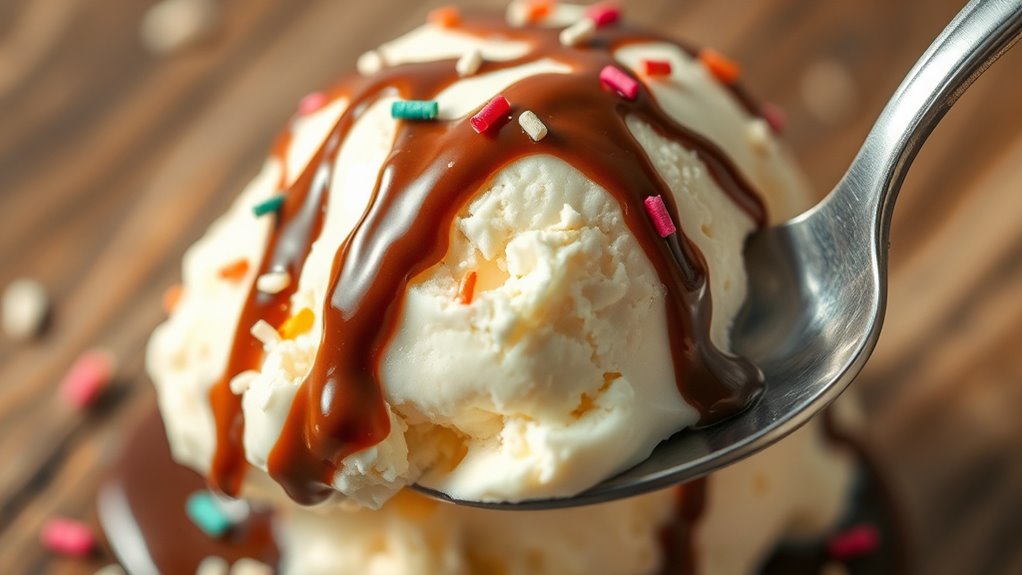
When you reach for a scoop of ice cream, it’s essential to understand its nutritional composition, as it can impact your overall diet. A typical cup of vanilla ice cream packs about 144.72 calories, with 2.52 grams of protein and 7.92 grams of fat, including saturated fats. You’ll also find approximately 16.99 grams of carbohydrates and 15.28 grams of sugar per cup. Nutritionally, it offers 92.16 mg of calcium, 75.6 mg of phosphorus, and 143.28 mg of potassium. While it provides some vitamins, like vitamin A and D, the high sugar and fat content can sway your cravings. Additionally, ice cream contains total saturated fatty acids of 4.89 grams. Consuming high amounts of saturated fat can have health implications, so it’s important to enjoy ice cream in moderation. Interestingly, the high sugar content can also trigger cravings for carbohydrate-rich foods like rice and corn-based meals, which are staples in Brazilian cuisine. For those seeking healthier alternatives, fresh fruit juices can offer a nutritious way to satisfy sweet cravings without excessive sugar and fat. Many people enjoy ice cream flavors like birthday cake ice cream, which can add to the overall appeal despite its nutritional drawbacks.
Cultural Significance and Historical Context

Ice cream isn’t just a delightful treat; it carries deep cultural significance and a rich historical context that spans centuries.
From ancient Persia and China to the Roman Empire, ice cream-like desserts evolved through various cultures. Emperors enjoyed flavored snow, while Persians innovated with Yakchal structures to store ice. Marco Polo’s introduction of sherbet to Italy further influenced ice cream’s development. The first recorded appearance of ice cream in 1671 England marked a significant moment in its historical journey, showcasing the evolution of culinary traditions that reflect social changes. Ice cream has also become a staple at Southern celebrations, often featured in gatherings that highlight Southern traditions.
Ice has symbolized purity in Aztec rituals and served as comfort food across generations. Sharing a scoop fosters social bonds and reflects local traditions, like Italian gelato or Mexican sorbet.
Celebrated during special occasions, ice cream connects you to history and culture, making each bite not just indulgent but meaningful.
Behavioral Patterns in Ice Cream Consumption

Though many people enjoy ice cream for its delicious taste, their consumption often reveals deeper behavioral patterns influenced by emotional and environmental factors. You might find yourself reaching for ice cream during stressful moments, seeking that boost in serotonin to elevate your mood. This emotional eating can create a cycle, as you associate ice cream with comfort and celebration, amplifying cravings tied to nostalgia. Interestingly, ice cream consumption can also enhance happiness and soothe emotions, further solidifying its role as a comfort food. You may also notice preferences for creamy textures and sweet flavors, which stem from both genetic factors and evolutionary signals. Additionally, environmental cues—like a sunny day or a festive gathering—can heighten your desire for this treat. Ultimately, these intertwined factors shape your ice cream consumption habits.
Marketing Strategies That Drive Demand

As you navigate the competitive world of ice cream, implementing effective marketing strategies can greatly boost demand for your products.
Start by launching a user-friendly website that showcases your flavors and shop experiences. Utilize social media platforms like Instagram and TikTok to create engaging content and promotions. A well-defined strategy helps navigate promotional efforts with clear objectives and distinguishes your shop from competitors.
Consider vibrant ads targeted to specific audiences. Email marketing keeps customers updated on new flavors and events.
Offer seasonal promotions, host fun ice cream-making events, and introduce limited-edition flavors to create urgency. Build loyalty through rewards programs and collaborate with local businesses.
Engage influencers to showcase your unique offerings, and emphasize sustainability in your practices to attract eco-conscious consumers.
These strategies can help you stand out and attract more customers.
The Addictive Nature of Ice Cream Cravings
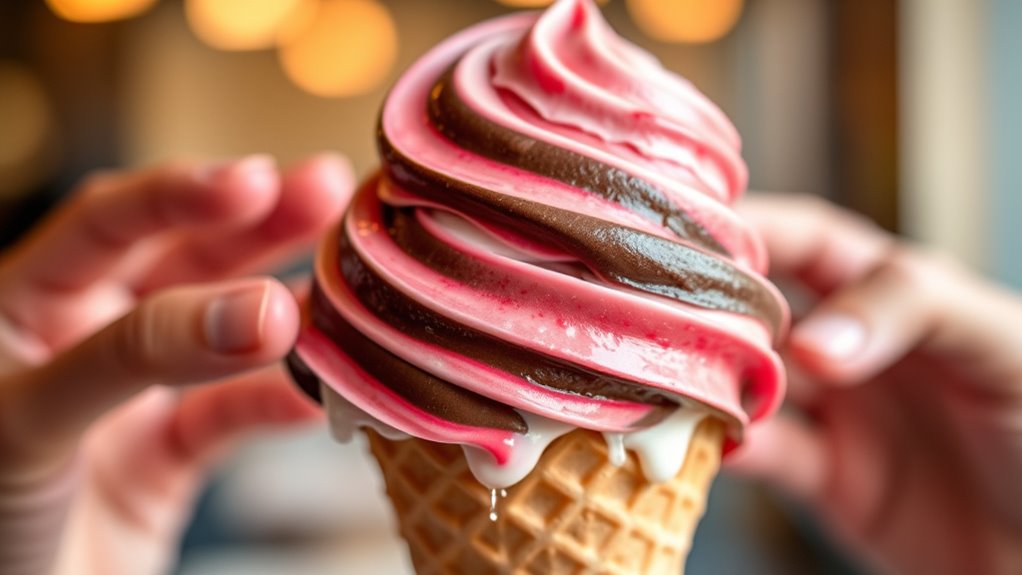
Effective marketing strategies can attract customers, but once you’ve got them hooked, you might notice a surprising phenomenon: ice cream cravings.
Studies show that ice cream shares addictive properties with drugs, leading to a cycle of increased consumption. The high-fat and high-sugar combo triggers your brain’s reward system, making each scoop feel rewarding at first. However, over time, you may need more to achieve that same pleasure. This happens because your brain’s dopamine response diminishes with frequent indulgence. Lower dopamine levels are linked to repeated consumption, making it even harder to resist that next scoop.
Ice cream’s high-fat, high-sugar blend can trigger a cycle of addictive consumption, rewarding your brain with each scoop.
Plus, the creamy texture and sweet taste heighten your desire, making it hard to resist. As you crave more, you might find yourself caught in a pattern of uncontrollable consumption, reflecting the addictive nature of this beloved treat.
Frequently Asked Questions
Why Do Some People Crave Ice Cream More Than Others?
You might crave ice cream more than others due to a mix of personal and biological factors.
Your unique genetic makeup influences how you perceive flavors and textures, while your past experiences shape your emotional connection to ice cream.
Environmental cues like hot weather can heighten your desire for cold treats.
Additionally, if you’re feeling stressed or nostalgic, you’re likely to reach for ice cream as a comforting choice.
Everyone’s cravings are personal and varied.
Can Ice Cream Cravings Indicate Nutrient Deficiencies?
When you feel that irresistible pull toward a creamy scoop of ice cream, it might hint at something deeper.
If you’re lacking calcium, magnesium, or potassium, those cravings could signal a nutrient deficiency.
However, don’t overlook the emotional side—stress or nostalgia might be driving you to the freezer.
While ice cream provides a temporary joy, balancing your diet with nutrient-rich foods could help satisfy those cravings more healthily.
How Does Weather Affect Ice Cream Cravings in Different Regions?
Weather greatly impacts your ice cream cravings, varying by region. In warmer areas, you’re likely to crave ice cream more during hot summer months. Conversely, cooler regions might see cravings year-round, even in winter.
On sunny days, you find yourself drawn to invigorating treats, while rain can dampen your desire temporarily. However, once the weather clears, those cravings can return stronger.
Your cultural background also shapes your preferences and consumption patterns.
Are There Healthier Alternatives to Traditional Ice Cream?
Yes, there are plenty of healthier alternatives to traditional ice cream.
You can try brands like Halo Top or Enlightened, which offer lower calories and added protein. If you prefer homemade options, consider blending frozen bananas for a creamy treat or making coconut milk ice cream for a dairy-free choice.
Greek yogurt ice cream is another protein-rich option, while sorbet provides a revitalizing, lower-calorie dessert.
Enjoy exploring these delicious alternatives!
What Role Do Genetic Factors Play in Ice Cream Preferences?
Did you know that genome-wide association studies have identified about 739 genetic markers linked to ice cream flavor preferences?
These markers influence how you perceive tastes and smells, shaping your flavor choices. Your genetic makeup interacts with environmental factors, like cultural influences and past experiences, to determine whether you lean towards chocolate, vanilla, or something else entirely.
Fundamentally, your genetics play a significant role in defining your unique ice cream preferences.
Conclusion
Just like a summer day beckons you to the ice cream truck, your cravings for ice cream are a playful dance between your brain and heart. They whisper sweet memories, cool you down, and fill you with joy. When you indulge, it’s as if you’re savoring a moment frozen in time, each scoop a reminder of life’s simple pleasures. So, next time you crave that creamy delight, remember: it’s not just ice cream; it’s a celebration of you.










